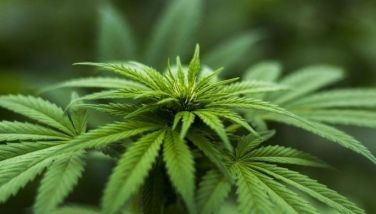And now, mistisang talong
June 5, 2005 | 12:00am
Mistisang talong, a new eggplant variety bred by a Los Baños scientist, continues to rate high among farmers in various parts of the country.
Its come-ons are its good qualities, particularly its high yield. As gathered by this writer, it has a maximum yield potential of 30 tons per hectare, as against the 15-20 t/ha of common eggplant varieties grown by farmers.
Tisay, as it has now come to be fondly called, is also resistant to weeds and plant pests and diseases and can weather typhoons.
The new variety is now being commercialized by the UP Los Baños College of Agriculture-Institute of Plant Breeding (UPLB-CA-IPB) through its National Seed Foundation (NSF), a nonprofit, nonstock service-oriented entity.
A small packet of seeds of mistisa costs P25 (a kilogram fetches P3,750).
Bred by Dr. Rodel Maghirang of UPLB-CA-IPB, mistisa is white with purple stripes, grows to 20 centimeters long, has a long shelf life and acceptable quality (good for various dishes, including pinakbet), and very prolific.
A research project titled "On-farm trials of eggplant" conducted recently by an IPB team led by Mr. Maghirang and supported by the Department of Agriculture-Bureau of Agricultural Research (DA-BAR) noted that mistisa was rated creditably by farmers in four study sites.
The study was done in Isabela in cooperation with the DA-Philippine Rice Research Institute (PhilRice); in Nueva Ecija with the Central Luzon State University (LSU) in Baybay town; and in Bukidnon with the DA Northern Mindanao Integrated Agricultural Research Center (NOMIARC).
The results in these sites have been encouraging, Ma. Luisa Guevarra of IPB, who was involved in the project, told this writer.
Mistisa also was among the cultivars included in a previous IPB project titled ‘Identification of eggplant varieties resistant to leafhopper, shoot and fruit borer, thrips, phomopsis blight, and bacterial blight’ funded by DA-BAR.
Involved in the project were Dr. Merdelyn Caasi-Lit, Dr. Nenita Opina, Dr. Maghirang, Edwin Rajotte, Raquel Lapiz, Ma. Amabel Capricho, and Rowena Urriza.
Dr. Lit told this writer that mistisa is tolerant to bacterial wilt and leafhopper and has resistance to shoot/fruit borer and phomopsis blight.
Shoot/fruit borer is the most serious insect pest of eggplant and the number one constraint to production of eggplant, which is now the country’s number one vegetable in terms of volume of production (166,086 tons per year valued at P1.8 billion) and hectarage (19,000 hectares).
Bacterial wilt is one of the most important diseases of eggplant in the country. Leafhopper damages the plant at vegetative stage by sucking the surface of the leaves.
Since it was bread and introduced, mistisa has been consistently gaining acceptance by farmer. In Asingan, Pangasinan, for instance, mistisa and another variety (EG203) were the farmers’ favorites. – Rudy A. Fernandez
Its come-ons are its good qualities, particularly its high yield. As gathered by this writer, it has a maximum yield potential of 30 tons per hectare, as against the 15-20 t/ha of common eggplant varieties grown by farmers.
Tisay, as it has now come to be fondly called, is also resistant to weeds and plant pests and diseases and can weather typhoons.
The new variety is now being commercialized by the UP Los Baños College of Agriculture-Institute of Plant Breeding (UPLB-CA-IPB) through its National Seed Foundation (NSF), a nonprofit, nonstock service-oriented entity.
A small packet of seeds of mistisa costs P25 (a kilogram fetches P3,750).
Bred by Dr. Rodel Maghirang of UPLB-CA-IPB, mistisa is white with purple stripes, grows to 20 centimeters long, has a long shelf life and acceptable quality (good for various dishes, including pinakbet), and very prolific.
A research project titled "On-farm trials of eggplant" conducted recently by an IPB team led by Mr. Maghirang and supported by the Department of Agriculture-Bureau of Agricultural Research (DA-BAR) noted that mistisa was rated creditably by farmers in four study sites.
The study was done in Isabela in cooperation with the DA-Philippine Rice Research Institute (PhilRice); in Nueva Ecija with the Central Luzon State University (LSU) in Baybay town; and in Bukidnon with the DA Northern Mindanao Integrated Agricultural Research Center (NOMIARC).
The results in these sites have been encouraging, Ma. Luisa Guevarra of IPB, who was involved in the project, told this writer.
Mistisa also was among the cultivars included in a previous IPB project titled ‘Identification of eggplant varieties resistant to leafhopper, shoot and fruit borer, thrips, phomopsis blight, and bacterial blight’ funded by DA-BAR.
Involved in the project were Dr. Merdelyn Caasi-Lit, Dr. Nenita Opina, Dr. Maghirang, Edwin Rajotte, Raquel Lapiz, Ma. Amabel Capricho, and Rowena Urriza.
Dr. Lit told this writer that mistisa is tolerant to bacterial wilt and leafhopper and has resistance to shoot/fruit borer and phomopsis blight.
Shoot/fruit borer is the most serious insect pest of eggplant and the number one constraint to production of eggplant, which is now the country’s number one vegetable in terms of volume of production (166,086 tons per year valued at P1.8 billion) and hectarage (19,000 hectares).
Bacterial wilt is one of the most important diseases of eggplant in the country. Leafhopper damages the plant at vegetative stage by sucking the surface of the leaves.
Since it was bread and introduced, mistisa has been consistently gaining acceptance by farmer. In Asingan, Pangasinan, for instance, mistisa and another variety (EG203) were the farmers’ favorites. – Rudy A. Fernandez
BrandSpace Articles
<
>
- Latest
Latest
Latest
April 10, 2024 - 5:12pm
By Ian Laqui | April 10, 2024 - 5:12pm
March 4, 2024 - 3:32pm
By Ian Laqui | March 4, 2024 - 3:32pm
March 4, 2024 - 2:12pm
By Kristine Daguno-Bersamina | March 4, 2024 - 2:12pm
February 17, 2024 - 2:31pm
February 17, 2024 - 2:31pm
February 13, 2024 - 7:24pm
By Gaea Katreena Cabico | February 13, 2024 - 7:24pm
Recommended




























